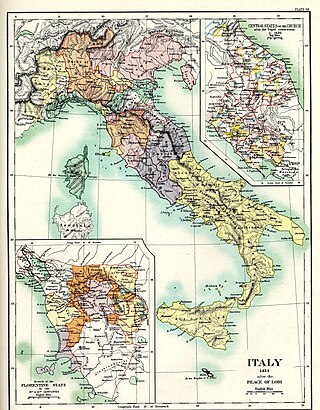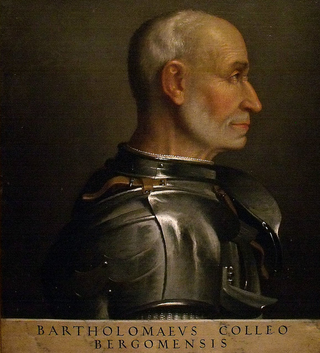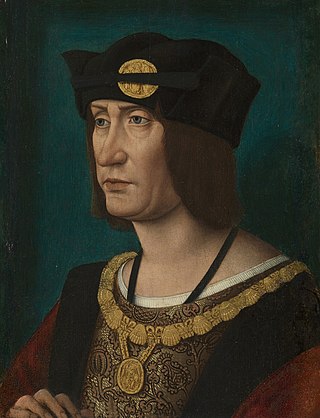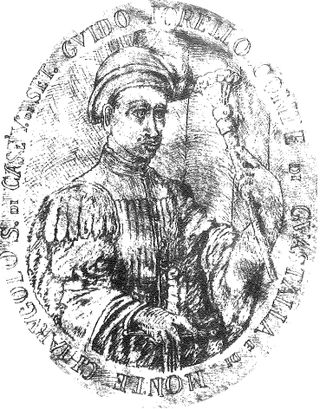Related Research Articles

Francesco I Sforza was an Italian condottiero who founded the Sforza dynasty in the duchy of Milan, ruling as its (fourth) duke from 1450 until his death.
1441 (MCDXLI) was a common year starting on Sunday of the Julian calendar, the 1441st year of the Common Era (CE) and Anno Domini (AD) designations, the 441st year of the 2nd millennium, the 41st year of the 15th century, and the 2nd year of the 1440s decade. As of the start of 1441, the Gregorian calendar was 9 days ahead of the Julian calendar, which was the dominant calendar of the time.

The Duchy of Milan was a state in Northern Italy, created in 1395 by Gian Galeazzo Visconti, then the lord of Milan, and a member of the important Visconti family, which had been ruling the city since 1277.

The War of the League of Cambrai, sometimes known as the War of the Holy League and several other names, was fought from February 1508 to December 1516 as part of the Italian Wars of 1494–1559. The main participants of the war, who fought for its entire duration, were France, the Papal States, and the Republic of Venice; they were joined at various times by nearly every significant power in Western Europe, including Spain, the Holy Roman Empire, England, the Duchy of Milan, the Republic of Florence, the Duchy of Ferrara, and the Swiss.

Filippo Maria Visconti was duke of Milan from 1412 to 1447. Known to be cruel and paranoid, but shrewd as a ruler, he went to war in the 1420s with Romagna, Florence and Venice in the Wars in Lombardy, but was eventually forced to accept peace under Pope Martin V. He would return to the offensive again where another peace agreement was required to end the fighting. He married twice, the second in 1428 to Marie, daughter of his ally Amadeus VIII. When he died, he was the last of the Visconti male line and was succeeded by Francesco Sforza, husband to his daughter.

Niccolò Piccinino was an Italian condottiero.

The Treaty of Lodi, or Peace of Lodi, was a peace agreement to put an end to the Wars in Lombardy between the Venetian Republic and the Duchy of Milan, signed in the city of Lodi on 9 April 1454.

The Golden Ambrosian Republic was a short-lived republic founded in Milan by members of the University of Pavia with popular support, during the first phase of the Milanese War of Succession. With the aid of Francesco Sforza they held out against the forces of the Republic of Venice, but after a betrayal Sforza defected and captured Milan to become Duke himself, abolishing the Republic.

The Italian Wars of 1499–1504 are divided into two connected, but distinct phases: the Second Italian War (1499–1501), sometimes known as Louis XII's Italian War, and the Third Italian War (1502–1504) or War over Naples. The first phase was fought for control of the Duchy of Milan by an alliance of Louis XII of France and the Republic of Venice against Ludovico Sforza, the second between Louis and Ferdinand II of Aragon for possession of the Kingdom of Naples.

Bartolomeo Colleoni was an Italian condottiero, who became captain-general of the Republic of Venice. Colleoni "gained reputation as the foremost tactician and disciplinarian of the 15th century". He is also credited with having refurbished the Roman baths at Trescore Balneario.

Bianca Maria Visconti also known as Bianca Maria Sforza or Blanca Maria was Duchess of Milan from 1450 to 1468 by marriage to Francesco I Sforza. She was regent of Marche during the absence of her spouse in 1448. She served as Regent of the Duchy of Milan during the illness of her spouse in 1462, as well as in 1466, between the death of her spouse and until her son, the new Duke, who was absent, was able to return to Milan to assume power.
The military history of the Republic of Venice started shortly after its founding, spanning a period from the 9th century until the Republic's fall in the 18th century.

The Wars in Lombardy were a series of conflicts between the Republic of Venice and the Duchy of Milan and their respective allies, fought in four campaigns in a struggle for hegemony in Northern Italy that ravaged the economy of Lombardy. They lasted from 1423 until the signing of the Treaty of Lodi in 1454. During their course, the political structure of Italy was transformed: out of a competitive congeries of communes and city-states emerged the five major Italian territorial powers that would make up the map of Italy for the remainder of the 15th century and the beginning of the Italian Wars at the turn of the 16th century. They were Venice, Milan, Florence, the Papal States and Naples. Important cultural centers of Tuscany and Northern Italy—Siena, Pisa, Urbino, Mantua, Ferrara—became politically marginalized.
Agnese del Maino was a Milanese noblewoman and the mistress of Filippo Maria Visconti, the last legitimate duke of Milan of the Visconti dynasty. Agnese was the mother of Duchess Bianca Maria Visconti.

Pier Maria Rossi or Pier Maria II de' Rossi was an Italian condottiere and count of a region around present San Secondo Parmense. His properties included the castle of Rocca dei Rossi. He was known as "the Magnificent".
The Milanese War of Succession was a war of succession over the Duchy of Milan from the death of duke Filippo Maria Visconti on 13 August 1447 to the Treaty of Lodi on 9 April 1454.

The Treaty of Blois (1499), signed on 9 February 1499, was a secret military alliance between Louis XII of France and the Republic of Venice, in which they agreed to a joint attack on the Duchy of Milan. In return, the Venetians were to receive part of the Duchy, while France also undertook to provide military assistance if Venice was attacked by the Ottoman Empire.

Guido Torelli was a condottiero. Through his military campaigns and diplomatic skills, he achieved the title of the first Count of Guastalla and Montechiarugolo.
References
- 1 2 3 4 5 6 Hazlitt 1900, p. 79.
- ↑ Hazlitt 1900, p. 89.
- ↑ Hazlitt 1900, pp. 79–80.